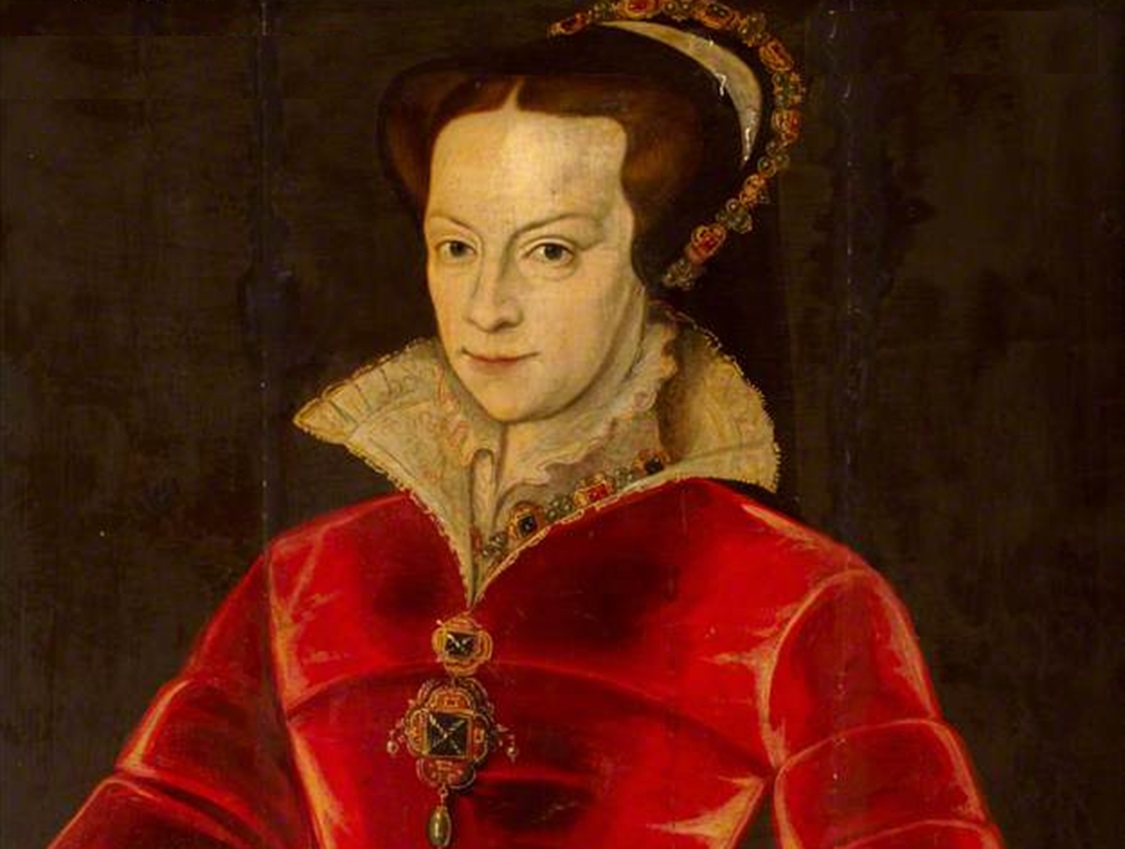Mary I of England’s Take and Stand on Religion
Religion is often perceived as mostly about prayers, songs, and giving, but underneath the surface, there is drama and sometimes even bloodshed. Mary I of England is one who resorted to bloodshed to fight Protestantism in favor of Catholicism. Here is the story.

Who Introduced Protestantism
To get to the story’s heart, we must start from the beginning—where did Protestantism come from? King Henry VIII, Mary I’s father, began the denomination in protest after the annulment of his first marriage was denied by the Roman Catholic Church Pope.
 After Hans Holbein the Younger, Wikimedia Commons
After Hans Holbein the Younger, Wikimedia Commons
Who Was King Henry VIII Married To?
King Henry VIII was married to Catherine of Aragon—mother to Mary I of England—for about 24 years, from June 11, 1509, to May 23, 1533. It was all rosy in the beginning, but the couple had misfortunes in the children's department.
 Lucas Horenbout, Wikimedia Commons
Lucas Horenbout, Wikimedia Commons
Six Pregnancies; One Child
During their marriage, Catherine of Aragon had six pregnancies, but only one child survived to adulthood. That was Mary I of England, who was born on February 18, 1516. Her mother allegedly had three stillborn children, gave birth to one son who died shortly after, and had one miscarriage.
 National Portrait Gallery, Wikimedia Commons
National Portrait Gallery, Wikimedia Commons
All These Unfortunate Events Strained The Relationship
Losing five kids would definitely cause tension in any relationship, and that is what transpired. King Henry VIII was particularly not pleased with the fact that he did not have a male heir. This was his reason for his request for the divorce.
 Hans Holbein the Younger, Wikimedia Commons
Hans Holbein the Younger, Wikimedia Commons
Henry VIII Approaches The Pope
Frustrated, Henry VIII approached Pope Clement VII with a request to annul his first marriage. He gave him his reasons and even informed him that he would marry Anne Boleyn to finally get a male heir. The Pope said no.
 Sebastiano del Piombo, Wikimedia Commons
Sebastiano del Piombo, Wikimedia Commons
Why Did The Pope Refuse?
At the time, the Pope himself was not having it smooth. He was under immense political pressure from Catherine’s nephew, Emperor Charles V. The Emperor had captured the Pope, so the Pope simply said no, not to offend the Emperor.
 Juan Pantoja de la Cruz, Wikimedia Commons
Juan Pantoja de la Cruz, Wikimedia Commons
Angry, Henry VIII Found A Way
You see, Catholicism did not allow divorce. So Henry VIII found a way to make it happen. He initiated a couple of legislative measures that gave rise to the English Reformation. Martin Luter, A German monk started the reformation by publishing a Ninety-Five Theses exposing the Catholic Church’s practices.
 Lucas Cranach the Elder, Wikimedia Commons
Lucas Cranach the Elder, Wikimedia Commons
The English Reformation Measures
First measure was the 1533 Act in Restraint of Appeals. This one basically stripped the power of the Roman Catholic church, especially in ecclesiastical matters—the Church’s beliefs, rules, and practices. It was no longer a law to appeal to the Roman Catholic church.
 John Gipkyn, Wikimedia Commons
John Gipkyn, Wikimedia Commons
Henry VIII Finally Got His Desire
Shortly, on November 3, 1534, according to the Act of Supremacy, Henry VIII was declared the Supreme Head of the Church of England. Henry VIII, now not bound by the Catholic church rules, could annul his marriage to Mary I of England’s mother.
 After Hans Holbein the Younger, Wikimedia Commons
After Hans Holbein the Younger, Wikimedia Commons
Henry VIII Dies At 55
Years later, in 1547, Henry VIII kicked the bucket at 55. The cause of his demise was severe obesity and an open ulcerated leg. He also had additional complications from a jousting accident. After his demise on January 28, 1547, his son Edward VI, Mary I’s half-brother, took over.
 Hans Holbein the Younger, Wikimedia Commons
Hans Holbein the Younger, Wikimedia Commons
Edward VI Was Only Nine
At only nine, Edward became ruler of England. Due to this, a regency council was formed to rule the country until he came of age. Unfortunately, he also kicked the bucket after six years on July 6, 1553 due to tuberculosis. His 6-year rule came with many religious rules.
 Circle of William Scrots, Wikimedia Commons
Circle of William Scrots, Wikimedia Commons
Edward VI’s Six Year Rule Had Changes
Edward implemented significant Protestant reforms, and he tried to alter the succession in favor of Lady Jane Grey (his Protestant cousin). He changed succession because he knew that Mary, his Catholic sister, would undo all his religious reforms if she ascended the throne.
 Unknown author, Wikimedia Commons
Unknown author, Wikimedia Commons
Edward’s Additional Implementations
Edward enforced the use of the Book of Common Prayer in English services, stripping away Catholic traditions and rituals. Churches were also cleared of Catholic imagery—no more statues of saints or elaborate altars. This didn’t sit well with Mary I of England.
 Circle of William Scrots, Wikimedia Commons
Circle of William Scrots, Wikimedia Commons
Mary I Wasn’t Having It
Edward’s reforms pushed England further away from Catholicism, and for Mary, a devout Catholic, this was a painful period. She found herself increasingly isolated, watching her faith being dismantled piece by piece. But that wasn’t all. Remember the succession altering? Queenship was also slipping through her fingers.
 Hans Eworth, Wikimedia Commons
Hans Eworth, Wikimedia Commons
Mary I Almost Become Queen
Instead of naming Mary as his heir before he passed on, Edward’s naming of Lady Jane Grey was to alter the succession. The idea was to keep England Protestant and prevent a return to Catholicism. Edward’s plan worked, but only for nine days after his death. How?
 Attributed to William Scrots, Wikimedia Commons
Attributed to William Scrots, Wikimedia Commons
Lady Jane Grey and the Nine Days’ Reign
On July 10, 1553, just days after Edward’s death on July 6, Lady Jane Grey was declared queen. It seemed that the Protestant nobles had won, but they underestimated Mary’s determination. Mary, with her rightful claim to the throne, wasn’t going to step aside so easily.
Mary I of England Wasn’t Going Down Without A Fight
Mary I quickly gathered support, especially from those loyal to her and the Catholic faith. Within nine days, Mary had mustered enough forces to march on London, oust Jane, and claim her throne. Lady Jane Grey’s reign was short-lived—just over a week.
 Manner of Antonis Mor, Wikimedia Commons
Manner of Antonis Mor, Wikimedia Commons
Mary I Ascends to the Throne
Through this feat of bravery, Mary had proven that she was not to be trifled with, and England now had its first reigning queen. She was officially proclaimed queen on July 19, 1553, and crowned on October 1, 1553, in Westminster Abbey.
 W H Egleton, Wikimedia Commons
W H Egleton, Wikimedia Commons
First Order Of Business—Fix Religion
Her ascension was celebrated by many, especially Catholics. England was deeply split between Catholics and Protestants, and tensions ran high. Mary just wanted stability and was determined to reunite the country under the Catholic Church. Protestant factions were not pleased by this.
 Hans Eworth, Wikimedia Commons
Hans Eworth, Wikimedia Commons
Protestants Protest
The powerful and influential Protestants were not willing to give up easily. So, they would rebel and cause religious unrest, as well as political obstacles at every turn. Did this tire Mary I of England from her goal? Nope! Not one bit.
 Hans Eworth, Wikimedia Commons
Hans Eworth, Wikimedia Commons
The Act of Repeal (1553)
One of Mary’s first acts as queen was to dismantle the Protestant reforms of her half-brother, Edward VI. In 1553, her Parliament passed the Act of Repeal, which undid many of Edward’s religious changes—the most important one being to reinstate the religious structure during her father’s reign.
 Unknown Author, Wikimedia Commons
Unknown Author, Wikimedia Commons
Mary’s Vision For England Was Unity
In her eyes, reuniting with Rome and the Pope would bring stability and moral righteousness to the kingdom. However, this vision placed her in direct conflict with many of her subjects who had embraced Protestantism. It was one kingdom, two fighting denominations.
 Ann Longmore-Etheridge, Flickr
Ann Longmore-Etheridge, Flickr
Attempt One: Marry A Spaniard
When 1554 came, Mary made a highly controversial decision—she married Philip II of Spain. From Mary’s perspective, this marriage was a brilliant political move. Philip was a powerful Catholic monarch, and their union would strengthen ties with Spain, one of the most influential Catholic nations in Europe.
 Sofonisba Anguissola, Wikimedia Commons
Sofonisba Anguissola, Wikimedia Commons
The English People Weren’t Ecstatic About This
The English people were not amused by the marriage. They feared Philip would dominate English politics and drag the country into Spain’s wars. The idea of a foreign king meddling in English affairs didn’t sit well with Parliament or the public. Instead, it caused further division.
The People Made Philip’s Reign Harder
Despite Mary’s hopes, her marriage to Philip II didn’t go as planned. Philip spent much of his time abroad, and many saw him as an absent foreign ruler with no real connection to England. Additionally, Parliament passed laws to limit Philip’s powers.
 Hans Eworth, Wikimedia Commons
Hans Eworth, Wikimedia Commons
The Wyatt Rebellion (1554)
In 1554, Thomas Wyatt, a Protestant nobleman, led a rebellion against Mary, aiming to depose her and prevent the Catholic restoration. The rebellion was driven by fear of foreign influence, as many English nobles worried that Mary’s marriage to Philip would lead to Spain controlling England.
 National Portrait Gallery, Wikimedia Commons
National Portrait Gallery, Wikimedia Commons
More Division
Wyatt’s forces marched on London, but the rebellion was swiftly crushed, and Wyatt was lynched. The failed uprising only strengthened Mary’s resolve to root out Protestantism, though it signaled just how divided her kingdom was. But a bigger issue lingered.
 Hans Holbein the Younger, Wikimedia Commons
Hans Holbein the Younger, Wikimedia Commons
No Heir
Here comes the kicker: the union produced no heirs! According to Mary, securing the future of Catholicism in England depended on producing an heir, but this dream would tragically never be realized. Twice during her reign, Mary believed she was pregnant, but both turned out to be false pregnancies.
 Lucas Horenbout, Wikimedia Commons
Lucas Horenbout, Wikimedia Commons
No Catholic Heir, Reforms Could Be Overturned
Without a Catholic heir, Mary’s reforms were at risk of being undone by her Protestant half-sister, Elizabeth. The lack of an heir left Mary vulnerable, and Protestant factions began preparing for the day when Elizabeth might take the throne.
 Unknown Author, Wikimedia Commons
Unknown Author, Wikimedia Commons
Mary I Of England Turns To Brute Force
By 1554, Mary was determined to stamp out Protestantism entirely, so she began a campaign of persecution against those refusing to return to the Catholic faith. Under her rule, heresy laws were revived, and Protestants who held firm in their beliefs were charged with treason or heresy.
 National Portrait Gallery, Wikimedia Commons
National Portrait Gallery, Wikimedia Commons
It Got Worse With The Marian Persecutions
The Marian Persecutions, as they would later be called, escalated in 1555 with the burning of Protestant heretics. Hundreds of Protestants were condemned to public slaying. This included prominent religious leaders like Archbishop Thomas Cranmer and bishops Hugh Latimer and Nicholas Ridley.
 Gerlach Flicke, Wikimedia Commons
Gerlach Flicke, Wikimedia Commons
Archbishop of Canterbury’s Change Of Heart
Thomas Cranmer, the former Archbishop of Canterbury under Edward VI was also taken out as he was responsible for many of the Protestant reforms. Initially, Cranmer recanted his Protestant beliefs, but at the last moment, he reversed it and reaffirmed his faith in front of a crowd.
 Samuel Freeman, Wikimedia Commons
Samuel Freeman, Wikimedia Commons
You Defy The Queen, You Perish
Thomas Cranmer’s public defiance made him a martyr in the eyes of Protestants, and he was taken out. This act further fueled anti-Catholic sentiment across the country. Such incidents just got worse. Was Mary I of England getting carried away?
 Lambeth Palace, Wikimedia Commons
Lambeth Palace, Wikimedia Commons
The Scale of the Persecution
The scale of Mary’s persecution was unlike anything England had seen before. In total, nearly 300 people were burned at the stake. These executions took place across England, with many of the victims being commoners who simply refused to abandon their Protestant faith.
Mary I, Why?
For Mary, these burnings were a necessary step toward purifying her kingdom, but for the victims and their families, it was a time of terror. The persecution left deep scars on the nation, and its memory would haunt Mary’s legacy for centuries.
 Elizabeth I (2017), Channel 5 Television
Elizabeth I (2017), Channel 5 Television
The Marian Persecutions Caused Further Divide
In Mary’s mind, she was doing her kingdom a favor, but did the people really see it that way? No, they did not. Even her supporters were getting terrified by her brutality. In response, protestant leaders who fled began writing pamphlets and treatises denouncing Mary as a tyrant.
 Unknown Author, Wkimedia Commons
Unknown Author, Wkimedia Commons
Birth Of Term ‘Bl**dy Mary’
All the backlash earned Mary the nickname Bl**dy Mary, but this name came later after her demise. The Protestant propaganda that spread across Europe painted her as a cruel and ruthless queen who delighted in the suffering of her Protestant subjects.
 Elizabeth I (2017), Channel 5 Television
Elizabeth I (2017), Channel 5 Television
She Tainted Her Own Legacy
The Marian Persecutions became the most infamous part of her legacy, overshadowing her other efforts to restore Catholicism. Though Mary’s reign lasted only five years, the label ‘Bl**dy Mary’ would stick with her and shape how future generations viewed her actions and policies.
 Metropolitan Museum of Art, CC0, Wikimedia Commons
Metropolitan Museum of Art, CC0, Wikimedia Commons
Was Mary I’s Rule All Bad?
Despite the brutality, Mary I still worked to bring stability to England after the chaotic reign of Edward VI. His brief rule had seen rapid reforms, leaving the kingdom in a fragile state. Mary’s ascension helped consolidate the monarchy’s power and restore a sense of order to the country.
 Ann Longmore-Etheridge, Flickr
Ann Longmore-Etheridge, Flickr
She Promoted Education
Mary I founded several educational institutions to provide opportunities for learning and advancement, especially within religious contexts. Her support for education extended to the Catholic Church, as she believed education would help strengthen the Church’s role in society.
 Jacopo da Trezzo, CC0, Wikimedia Commons
Jacopo da Trezzo, CC0, Wikimedia Commons
She Supported Charities Too
Beyond education, Mary was also known for her charitable works. She supported efforts to help the poor and needy. This queen ensured that some of her resources were directed toward social welfare programs. These contributions highlight a more compassionate side to her reign.
 Ann Longmore-Etheridge, Flickr
Ann Longmore-Etheridge, Flickr
She Made Economic Reforms: The New Coining System
Mary I’s notable achievement was the introduction of a new coining system. This reform was aimed at addressing the issues caused by the debasement of currency. By stabilizing the currency, Mary helped restore confidence in the English economy and paved the way for more sustainable economic growth.
 Ann Longmore-Etheridge, Flickr
Ann Longmore-Etheridge, Flickr
She Was Also A Patronage of the Arts and Culture
During her reign, Mary I’s court supported artists, musicians, and writers, and this fostered a revival of cultural expression. Though her reign was relatively short, her contributions to the arts helped maintain the rich tradition of English culture.
 Ann Longmore-Etheridge, Flickr
Ann Longmore-Etheridge, Flickr
Was It Truly A Balanced Legacy?
While much of Mary I’s reign is remembered for the religious persecution of Protestants, there were other dimensions that deserve recognition as you’ve seen—education, charity, and economy. But the big questions are; Does that balance her legacy? Or was it a case of desperate times calling for desperate measures?














